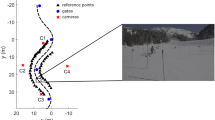Abstract
This study was performed to investigate the effects of changes in the skiing posture on mechanical stress across the knee joint. The aim of the present study was to establish a safer form of skiing for the prevention of injury to the anterior cruciate ligament of the knee (ACL). Ten healthy volunteers were placed on a force plate on an artificial slope, and assumed forward and backward bending postures with a single leg by changing their centre of gravity. The knee flexion angles were limited to approximately 30° by orthotics in each posture. Joint moments of the lower extremity were analyzed using a motion analysis system, and the muscle activities of the lower extremity were recorded by EMG and digitised to integrated EMG in each posture. In addition, extrusion of the lower leg by the boot was measured using a force sensor sheet inserted behind the calf. We found that the extension moment of the hip and ankle joints, and muscular activity of the hamstrings were increased in forward bending, whereas the extension moment of the knee and muscular activity of the quadriceps were decreased. Conversely, the muscular activity of the quadriceps, the flexion moment of the hip, extension moment of the knee joint, and pressure of the boot were increased in backward bending, whereas muscular activity of the hamstrings was decreased. The dependency on the hamstrings increased in forward bending in a skiing posture on a slope with slight knee flexion. Therefore, forward bending seemed to be an advantageous posture for the prevention of ACL injury. Conversely, in a backward bending skiing posture, the extension moment of the knee joint produced by muscle contraction of the quadriceps also increased imbalance in the hamstrings. The results of this study suggest that the internal force exerted by the quadriceps, in addition to the passive factor of extrusion of the lower leg by the boot, may contribute to non-contact ACL injury in a backward bending posture while skiing.








Similar content being viewed by others
References
Aune AK, Schaff P, Nordsletten L (1995) Contraction of knee flexors and extensors in skiing related to the backward fall mechanism of to the anterior cruciate ligament. Scand J Med Sci Sports 5:165–169
Aune AK, Cawley PW, Ekeland A (1997) Quadriceps muscle contraction protects the anterior cruciate ligament during anterior tibial translation. Am J Sports Med 25:187–190
Beynnon BD, Pope MH, Wertheimer CM et al (1992) The effect of functional knee-brace on strain on the anterior cruciate ligament in vivo. J Bone Joint Surg (Am) 24A:1298–1312
Chiang AL, Mote CDJ (1993) Translations and rotation across the knee under isometric quadriceps contraction. In: Johnson RJ, Mote CDJ, Zelcer J (eds) Skiing trauma and safety: ninth international symposium. American Society for Testing and Materials, Philadelphia, pp 62–74
DeMorat G, Weinhold P, Blackburn T et al (2004) Aggressive quadriceps loading can induce noncontact anterior cruciate ligament. Am J Sports Med 32:477–483
Draganich LF, Vahey JW (1990) An in vitro study of anterior cruciate ligament strain induced by quadriceps and hamstrings forces. J Orthop Res 8:57–63
Durselen L, Claes L, Kiefer H (1995) The influence of muscle forces and external loads on cruciate ligament strain. Am J Sports Med 23:129–136
Elmqvist LG, Johnson RJ (1994) Prevention of cruciate ligament injuries. In: Feagin JA (eds) The crucial ligaments: diagnosis and treatment of ligamentous injuries about the knee, 2nd edn. Churchill-Livingstone, New York, pp 495–506
Fleming BC, Beynnon BD, Renstorm PA et al (1999) The strain behavior of the anterior cruciate ligament during stair climbing: an in vivo study. Arthroscopy 15:185–191
Fleming BC, Renstrom PA, Ohlen G et al (2001) The gastrocnemius muscle is an antagonist of the anterior cruciate ligament. J Orthop Res 19:1178–1184
Giffin JR, Vorgrin TM, Zantop T et al (2004) Effects of increasing tibial slope on the biomechanics of the knee. Am J Sports Med 32:376–382
Howell SM (1990) Anterior tibial translation during a maximum quadriceps contraction: is it clinically significant? Am J Sports Med 18:537–538
Johnson RJ, Ettinger CF, Shealy JE (1993) Skier injury trends. 1972–1990. In: Johnson RJ et al (eds) Skiing trauma and safety: ninth international symposium. American Society for Testing and Materials, Philadelphia, pp 11–22
Kennedy JC, Weinberg HW, Wilson AS (1976) The anatomy and function of the anterior cruciate ligament. J Bone Joint Surg (Am) 56A:223–235
Kobayashi T (1995) Biomechanics of ski-jumping. In: Ishii S, Sugawara M, Mutoh Y(eds) Medicine in skiing. Nankodo Co Ltd., Tokyo, pp 17–25
McConkey JP (1986) Anterior cruciate ligament rupture in skiing. A new mechanism of injury. Am J Sports Med 14:160–164
Shino K, Horibe S, Nagano J et al (1987) Injury of the anterior cruciate ligament of the knee in downhill skiing: its pathomechanism and treatment. Skiing Trauma and Skiing Safety, pp 68–76
Yasuda K, Sasaki T(1987) Exercise after anterior cruciate ligament reconstruction. The force exerted on the tibia by the separate isometric contraction of the quadriceps or the hamstrings. Clin Orthop 220:275–283
Acknowledgement
This work was supported in part by a Grant-in-Aid 15500469 for Scientific Research from the Ministry of Education, Science and Culture of Japan.
Author information
Authors and Affiliations
Corresponding author
Rights and permissions
About this article
Cite this article
Koyanagi, M., Shino, K., Yoshimoto, Y. et al. Effects of changes in skiing posture on the kinetics of the knee joint. Knee Surg Sports Traumatol Arthrosc 14, 88–93 (2006). https://doi.org/10.1007/s00167-004-0609-2
Received:
Accepted:
Published:
Issue Date:
DOI: https://doi.org/10.1007/s00167-004-0609-2




